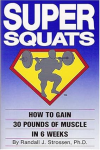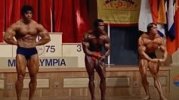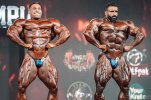the hack squat is now considered the number 1 leg exercise for hypertrophy, outranking even the back squat.
Hack Squat Quad Development
Hack Squats primarily emphasize Quad Development
.
Developing Quads with Squats
To develop maximize Quads with Squats...
1) High Bar Back Squats
This place greater loading on the Quads; more so than Low Bar Powerlifting type Squats.
2) High Heel Back Squats
This shift the loading ever more so to the Quads.
3) Front Squats
Quad OverLoad occur with these Front Squats.
4) Safety Bar Squats
This elicits Quad development in a somewhat similar way to Front Squats; the workload is shifted forward, placing greater stress on the Quads.
5) Sissy Squats
This Squat place and enormous amount of work on the Quads.
Sissy Squats, along with Seated Leg Extension, are two of the most effective movement that develop the Rectus Femoris.
Shear Force
A lot of Shear Force is place on the knees with Hack Squats, Sissy Squats and Leg Extensions; which might be an issue for some.
higher reps... The majority reporting ~20 rep sets as a staple of their hypertrophy routines. That would also be a change from, say, 10 years ago when fewer would have been lifting above 12 reps at most.)
Higher Repetitions
Hypertrophy Training of 20 Repetition plus per set for Bodybuilding have been utilized for decades.
Tom Platz was a huge advocate of Mega High Repetitions.
Platz 23 Reps with 525 lbs (aka Quadzilla)
Super Squats

This method involves working up to one 20 Repetition Squat Set along with a high calorie diet for gaining weight.
The training objective is to perform one 20 Repetition Set of Squats with 150% of your Body Weight.
Back in the 1960's, John McCallum referred to it as "Breathing Squats".
Performing Super Squat/Breathing Squats continues to be very effective for gaining Muscle Mass and Body Weight, in conjunction with Diet.
Mega Repetition
To reiterate, Bodybuilders have used this method for decades and still use it today because it works.
Let's examine its similarity to...
Occlusion Training
This means slight wrapping an arm or leg with a tourniquet; on a scale of 1-10, discomfort should be around 6-7 to be effective.
Blood is pumped to the working muscles (Arterial Blood Flow). However, the tourniquet restricts blood from being pumped back to the heart (Venous Blood Flow).
Research shows (Dr. Jeremy Loenneke) that Occlusion Load of around 30-50% of 1 Repetition Max, performed for 30 Repetition Sets optimized Muscle Hypertrophy.
This produces a Mega Pump. The Pump has been show to produce a downstream effect that triggers Muscle Growth.
Ironically, Bodybuilder unknowingly elicit a similar Hypertrophy Effect with Mega High Repetition Sets.
The Traditional Bodybuilding Pump
When a muscle contracts it limits Venous Blood Flow back to the heart.
Blood is then trapped in the Muscles Trained, ballooning them up, producing The Pump.
The longer the Muscles are Contracted in an Exercise with Higher Repetitions, the more blood is pumped to the Muscles, the greater The Pump; more blood is trapped in the Muscles.
Short Rest Periods between Hypertrophy Sets of 30-60 second, limit the amount of Venous Blood Flow Back to the heart.
In other words, Shorter Rest Periods between sets ensure less blood flows back to the heart, enabling a lifter to maintain The Pump.
The next two set or more, continue to magnify The Pump.





